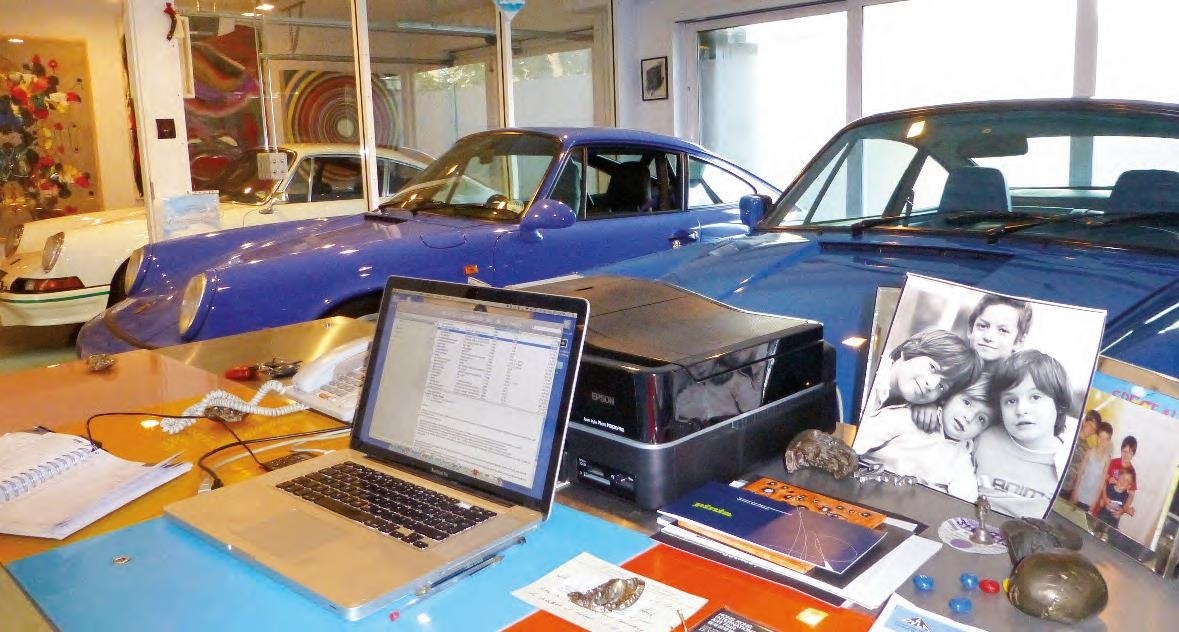Laptop on desk, photo of the family, Carrera RS (911 and 964 variety), 930 Turbo…Yup, just your normal everyday office. Kenny
Schachter’s working environment is a shrine to Porsches and modern art.
My car obsession, bordering on a fetish, sprang from being an alienated overweight child with a feeling for aesthetics and speed, but no notion of art (or sports).
Growing up on Long Island in the 1970s was shaped more by Road & Track than Art & Auction, which left an indelible mark – and lasting passion. Since I moved to the UK eight years ago, I have bought and sold nearly 70 cars, admittedly 99 per cent of them for a loss – save for a 1964 Hillman Imp moved on for £1500, which is what I had paid for it.
I am not vastly bothered by the lack of return since living with such a varied cast of stablemates has a more palpable yield in the way of visceral enjoyment; and live with them I do: the nose of one rests, quite literally, under my desk.
I have the lungs of a mechanic but don’t know how an engine functions. To first sit in a car, smell it, see and touch the lines, turn the key and drive is like meeting a great new friend, or listening to a catchy tune for the first time – you get a feeling of familiarity that plants deeply in the mind.
Sadly, driving in the UK throws up a few immediate obstacles for me, namely I have never attained full perceptional abilities, or confidence, to navigate the UK’s ultra-narrow two-way roads that barely meet the criteria for an alley in the USA. That makes passage through the curb restrictors of the Hammersmith Bridge on the school run a daily source of anxiety. I go through lots of sets of rims. As a result, the first and foremost parameter when choosing every car I have owned is width.
Next comes my pathological fear of getting lost, which in grid-less London makes it all but impossible for me to find anything other than the newsagent at the end of my street.
Lastly, my neurotic distaste for the paralyzing pressures of a road test for my license at this stage of my life: call it old-dogs-new-tricks syndrome. The right to legally rely on the New York documentation still in my wallet has long since lapsed, but let’s keep that tidbit amongst ourselves, please.
Besides collecting and admiring cars for most of my life, I have launched a series of adventures in the world of commissioning cars with the hope of producing limited-run editions. Victor Gauntlett, a former owner of Aston Martin said: ‘Can you make a small fortune in the automobile industry? Yes, if you start out with a large one.’
Never one to focus too much on sound advice, I began with Zaha Hadid by commissioning two iterations of a car, a more conceptual three-wheel version, and with the idea of production and marketability in mind, a subsequent more traditional layout of four wheels. We ended up with two nonfunctioning full-scale models that have been exhibited worldwide, and which now have more frequent flier miles than I do. One of them is now in the permanent collection of the Philadelphia Museum of Art.
The car creation gig got me lecturing and thesis-advising to a sometime hostile audience at the Royal College of Art, Vehicle Design Department, which is among the very best. I say hostile because when it becomes apparent from time to time how out of my depths I am, the students are none too shy about letting me know about it.
With the thought of an overlapping car, art and architecture show, there have been additional renderings by the likes of Kenny Scharf who designed a cartoon car come to life; Vito Acconci, a conceptual artist, created a car based on the airbag which looks like the Nike sneaker of the future; and Arik Levy, an industrial designer who penned a faceted vehicle more like a menacing military machine.
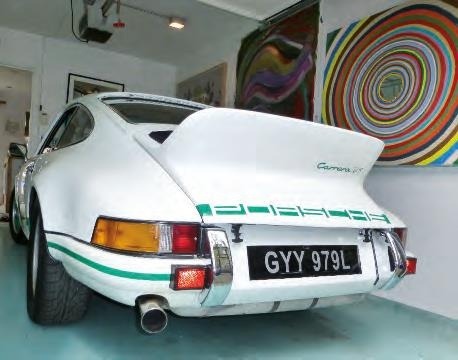
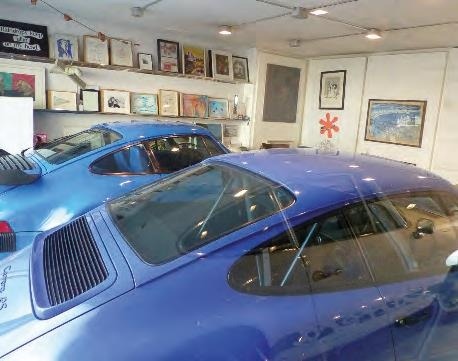
M471 ‘Lightweight’ rubs shoulders with artwork commissioned by Schachter.
He’s also got a passion for blue – not just any blue, but the hues chosen by Porsche to adorn their finest cars
There have also been commissions of boats by Zaha (motorboat) and Rem Koolhaas (hybrid sail and motor), the first of which is less than a year away from completion. To be frank, I don’t even particularly like boats or water for that matter, but the upside is a climate of much less regulatory hurdles for seaworthiness. And, more importantly, lower points of entry from a financial perspective. Who would be my dream collaborators of the future? It could only be the people I am working with already – I’d be hard-pressed to imagine better.
About the art-car connection, I believe anything done extraordinarily well is art – I don’t differentiate between a fork, a car, a sculpture or a painting. I want to live a life fully integrated and not characterized by (false) hierarchies. In Octane magazine, Stephen Bayley said ‘If you want to know about the beliefs, fears, desires and preoccupations of America in 1957, you would be far better off studying a Chevy Bel Air than a David Smith abstract sculpture of the same year.’
As an aside, it’s amazing UK car magazines undertake to discuss art at all – I am fairly certain no US magazine ever has, or would – but the author is misguided.
Bayley states that art doesn’t make you feel alive like a car with, quoting Tom Wolfe: ‘freedom, style, sex, power, motion, colour, everything’.
But why must the two be mutually exclusive? Great art has all the attributes Wolfe ascribed to cars, while certain cars are sculptural, and more. Sure, you can’t drive a painting, but you can’t bed your Bugatti, either. But why is the Porsche Carrera RS 2.7 M471 the defining car for me and my life? As the recently deceased Ferdinand ‘Butzi’ Porsche put it so succinctly: ‘A product that is coherent in form requires no embellishment. It is enhanced by the purity of its form.’
The RS is a car so compact and precise that there is absolutely nothing superfluous; like all great art and design, it’s as if it always just existed. Plato spoke of a philosophical Purity of Form – a theoretical, abstract idea – but I’d go so far as to say that the 911, in its all-encompassing perfection of shape and performance, comes as close to a real life example of this as you can imagine.
If you stand with your feet under the car, thus cropping out the purposeful front bumper, the RS appears so slight and unprepossessing with its narrow footprint that it resembles a 3/4-scale model. It’s the most direct and compact shape imaginable that seduces with simplicity. And that’s all before you start the engine!
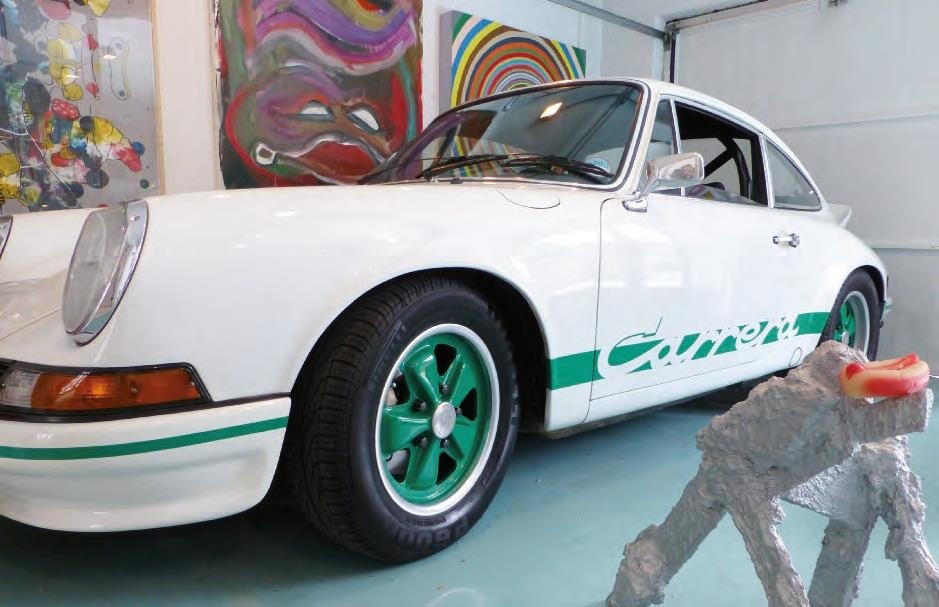
Green on Grand Prix White is a classic combination but one which is rarely seen, which is a shame in our books. The owner’s love of blue didn’t stop him from ‘straying’ in this instance…
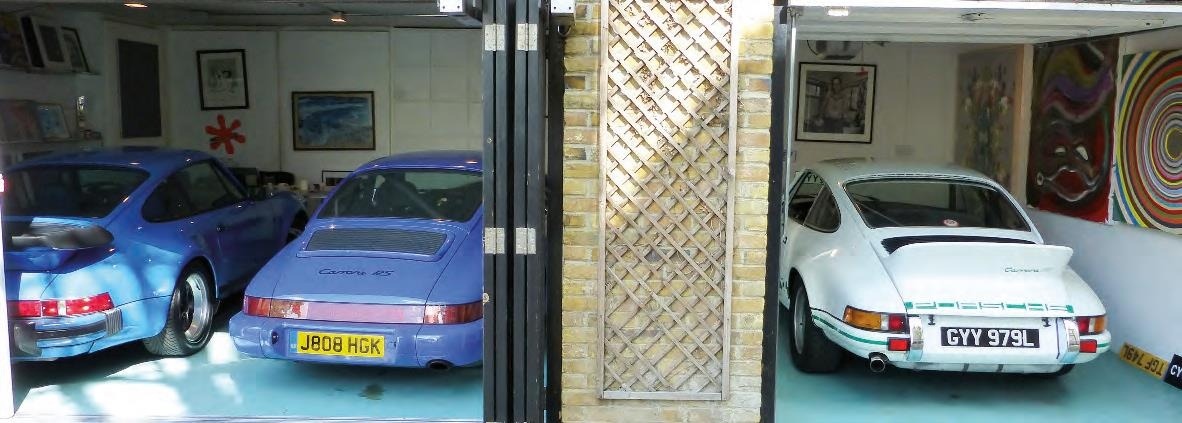
From the outside, it might look like just your average mews-style garage, but throw open the doors and you step into another world of fine art and even finer cars. Surely it’s every art lover’s dream garage?
But before that happens, there are the bucket seats shaped like a cupped hand, with the proportions just so right that it would make Goldilocks blush. The hardware to adjust the seats – no more than a fixed bolt with a circular screw – is positively sculptural. And the colours: nothing beats the lurid hues of 1970s Porsche greens, yellows, blues and oranges.
My M471 ‘Lightweight’ would be a different car without the Carrera script ripping across the bodywork, and the electrifying acid green wheels; sure, it would still be a great looking and driving car – just not the same.
Driving and looking at the car are two very different, equally rewarding activities. On the road, you melt into the car, where you can actually feel the resistance of tyre on tarmac. Acceleration is immediate and fierce and, despite moaning about gearbox vagueness, I find it notches in like a bone snapping into a joint.
The urge to keep up the throaty snarl of the exhaust is so tempting as to amount to a danger to pedestrians and small animals – not to mention the constant threat of incarceration it poses. At 5000 revs in second gear, driving an RS is like a blast of adrenaline through the heart (and ears): a delicious, infectious cacophony leaving me constantly wanting for more.
The experience is like trying to control a heeling dog on the verge of lunging (or, if you are a feline person, a cat with its back arched about to strike); you can feel the urge to pounce before it even happens. The potential of the Carrera is never too far from the surface, yet to consider how effortless, responsive and willing it is boggles the mind, body and soul.
Call it the perfect city car! Having spent my last pennies on my latest Carrera, my wife was less than amused to find out that I can’t stop driving the damned thing, I guess she figures she is not the only person that drives around London as if it were a contact sport. Still, despite the risk to what has become such a highly-valued collector’s object, I just can’t wait to get behind the wheel each and every time and feel the limits – around Hyde Park and Chelsea I sometimes imagine I’m in a rally, avoiding bikers like trees. Let’s call that another secret amongst friends.
I’ve owned a few RSs, now. The first was also an M471 Sport (‘Lightweight’, in popular paralance). It was left-hand drive, bought in Germany, 50,000km on the clock. It was unmolested, one of the first 200 ever made – I purchased it from a Nazi memorabilia collector extraordinaire, located 90km outside of Nuremberg. It was probably one of the most original cars of its sort in existence. Prior to delivery, the seller phoned to determine if he might ask a personal question, which was: ‘Are you Jewish?’
Though I didn’t fully understand (or appreciate!) why, I guess he meant it to be reassuring. He even forwarded images of his mannequin-clad collection, which I believe is a Federal crime in Germany still, and surely a new definition of creepiness. I must really love cars.

Original 1973 RS is separated from its more modern 964-based sibling by a sliding glass panel – it’s a subtle hint at how Schachter regards his latest purchase. It really is something special…
Next came another Carrera RS M471 (Lightweight) – yes, another of the same as above, a few years after I was massaged into selling the previous by the IRS. But by the time I found this replacement (a white car with green stripes), the market had moved so much I had to pay more for less. Because these cars are the Holy Grail among Porsche aficionados for the clarity of design and rawness of drive, the prices seem to go in one direction only – and swiftly at that.
As mentioned, the seat hardware and duck-tail spoiler alone are enough for me. The upcoming 40th anniversary of the model kicks off with celebrations launching in September 2012 and carrying on throughout the year. Though my mechanic is usually a stickler for details on his myriad inspections, I noticed going over old racing photos of the car that there had been an antenna, but the hole had since been welded and painted over – a no-no for originality and almost amounting to crime. Now whenever I see the front quarter panel, driver’s side, my eye darts to the covered hole, seeing something that’s no longer there.
I’ve watched specialized mechanics on all fours painstakingly spend hours inspecting every screw holding these cars together, flashlight between clenched teeth. The degree of minutiae is numbingly mind-boggling: here you have the anorak on a whole other level.
This car is, according to the seller, ‘ex-Eugen Strahl (former Le Mans driver for Team Sauber) with 89,800km from new, original body, original engine, matching numbers, chassis number untouched, original production number untouched. The second owner kept the car for 30 years, with its original seats, interior, steering wheel and rims. This is an authentic, numbers-matching, original 1973 M471 Sport, one of 200.’ Let’s hope he was right. Someone just told me of the total of 1580 Porsche 911 Carrera RSs made, there are 4500 for sale at any given time.
Then there’s the modern equivalent, if we can call it such: a 1992 964 RS, in Maritime Blue, with 22,609km. It’s a left-hand drive, ‘comfort’ model (as opposed to the hardcore, stripped-out Clubsport), with the original panels undisturbed, and a dealer-fitted half roll-cage. It still has the original paint on the whole car, including wheels, with the exception of the driver’s-side wing – there’s a story of a factory repaint around purchase time that cannot be verified but is believable.
Like the last RS that came nearly 20 years before, this is a street-legal hardcore racecar for the road, but in my case bought as much for the triple blue seats – I do like blue! It’s a very focused and unforgiving driving experience where every cigarette butt can be felt in the butt; and, as with the M471 Sport, there are the inimitable seats. It’s interesting to note that it’s the very same width as the earlier iteration of the RS at 65 inches wide – an essential ingredient in my ongoing affections.
I am such a fan of the Porsche blues that I commissioned the early conceptual artist from New Zealand, Billy Apple, to make a work based on the many variants. The result is described as: ‘From the Rove Collection. A painting by Billy Apple completed September 2011. Three painted blue stripes (Porsche Maritime, Monaco and Riviera Blue) on primed linen with white text. Two-pack clear-coat over coloured base coat and computer cut vinyl text. Cedar stretcher 1000 x 618mm,’ to be exact.
This is not to mention I’ve inspired and commissioned quite a bit more car-related art, from work by stainedglass artist Brian Clarke to a collective of up and coming New York based artists by the name of ‘The Bruce High Quality Foundation’.
Art and cars? Who said you can’t have your cake and eat it? Just not in one of my Porsches, please.

Built in June 1973, chassis #911 360 1580 is a genuine M471 Sport, which was owned and raced by Eugen Strahl extensively throughout 1974
Kenny Schachter

